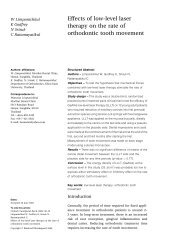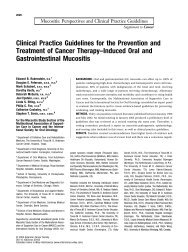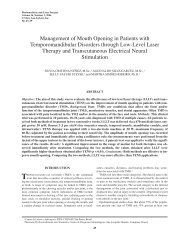A New Method for Hemorrhoid Surgery ... - ResearchGate
A New Method for Hemorrhoid Surgery ... - ResearchGate
A New Method for Hemorrhoid Surgery ... - ResearchGate
Create successful ePaper yourself
Turn your PDF publications into a flip-book with our unique Google optimized e-Paper software.
144<br />
In 2000 Zahir et al. 17 per<strong>for</strong>med a retrospective study comparing<br />
a total of 50 patients, half of whom had laser surgery,<br />
and half of whom had conventional hemorrhoidectomy, and<br />
concluded that those receiving the laser treatment had less postoperative<br />
pain and reduced hospital expense, as the patients<br />
treated with lasers were discharged sooner.<br />
In recent years surgeons have developed a new technique to<br />
treat variceal veins of the inferior limbs with a diode laser. 18<br />
This endovascular technique allows the treatment of the enlarged<br />
veins with no need <strong>for</strong> several skin incisions, since it can<br />
be per<strong>for</strong>med as ambulatory surgery.<br />
Plapler et al. 19 studied the effect of the diode laser (810 nm<br />
wavelength) on interstitial tissue of the anal region of rats and<br />
showed that the diode laser leads to minimal alteration, as long<br />
as one keeps in mind rules governing laser-tissue interactions.<br />
This study details an investigation of endovascular hemorrhoidectomy<br />
using a diode laser, to determine its feasibility<br />
<strong>for</strong> this indication, and to ascertain if improvements in<br />
follow-up are seen. Since there is no exposure of the muscular<br />
layer or nerves to laser energy, one might expect a considerable<br />
reduction in postoperative pain with better patient<br />
outcome. The objective is to determine the effectiveness of<br />
diode laser energy in treating hemorrhoids in an experimental<br />
model in monkeys.<br />
MATERIALS AND METHODS<br />
This project was approved by the Ethics in Research Committee<br />
at UNIFESP/HSP, CEP protocol number 0615102, and<br />
the license to capture, collect, transport, and per<strong>for</strong>m experiments<br />
on the animals was granted by the Brazilian Institute of<br />
the Environment and Renewable Natural Resources (IBAMA),<br />
under process number 02027.007959/98-53.<br />
Study sample<br />
Ten male nail monkeys (Cebus apella), average age 12 y,<br />
weighing between 3.5 and 4.5 kg, procured from the Centro de<br />
Reabilitação Animal do Parque Ecológico do Tietê–DAEE were<br />
<strong>Hemorrhoid</strong> 10 d after inferior hemorrhoidal vein lig-<br />
FIG. 1.<br />
ation.<br />
FIG. 2.<br />
sent to the veterinary hospital of Bandeirante University of São<br />
Paulo (UNIBAN), where they were kept in individual cages<br />
with appropriate food and water. They were kept under these<br />
conditions <strong>for</strong> 5 d so they could adapt to the new environment<br />
and adjust their circadian rhythm.<br />
Anesthetic protocol<br />
The animals were anesthetized with an intramuscular injection<br />
of ketamine chloride 15 mg/kg, midazolam 0.5 mg/kg, and<br />
atropine sulfate 0.02 mg/kg; venous access via the cephalic vein<br />
was provided <strong>for</strong> fluid infusion (10 mL/kg/h). Anesthesia was<br />
maintained with isofluorane in oxygen (1.5 L/min) given via a<br />
3.5F tracheal tube.<br />
Experimental protocol<br />
Plapler<br />
Image of the laser fiber inserted into the hemorrhoid.<br />
The experimental model used to induce hemorrhoids has<br />
been previously described. 20 Under general anesthesia, we<br />
per<strong>for</strong>med a perineal incision in the edge of the external<br />
sphincter of the anus on the right side, and isolated and tied<br />
the inferior hemorrhoidal vein with absorbable 3-0 Vicryl ® .<br />
The incision was closed by continuous suture with absorbable<br />
4-0 catgut.<br />
The animals were examined daily to assess their hemorrhoids,<br />
which were seen on about the tenth postoperative day.<br />
Once the piles were identified (Fig. 1), the animals were<br />
anesthetized and placed on the operating table. The hemorrhoid<br />
was then punctured and the diode laser (Diamond Lasers, London,<br />
UK) delivered energy through an optic fiber (Fig. 2) of<br />
600 m, emitting a wavelength of 810 nm at 1–2 W in 1-sec<br />
pulses, pulling the fiber gradually outward until the pile was<br />
sealed. The total amount of energy delivered was 4–10 J. These<br />
parameters were determined experimentally because they were<br />
found to seal the vein, but caused no visible thermal damage to<br />
the surrounding tissue.<br />
The animals were observed daily and 9 d after the laser therapy<br />
we collected a sample of tissue from the treated region <strong>for</strong><br />
histological analysis, and mucosa obtained from the left side<br />
was used as a control. Ten days after the laser procedure the<br />
animals were fully active and in good health.











